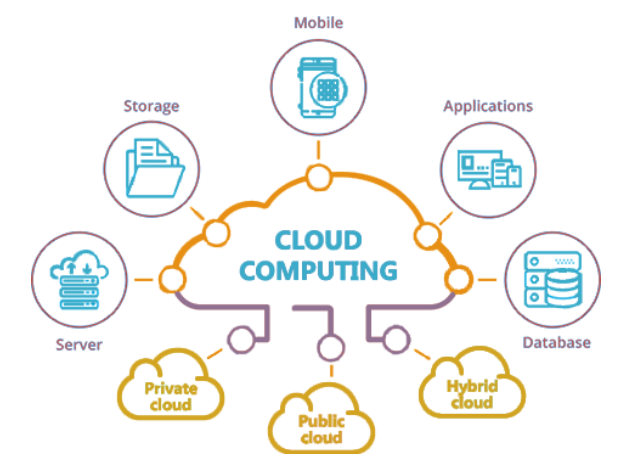Technology
Cloud Computing: The Backbone of Modern IT Infrastructure

In today’s digital age, businesses of all sizes rely on robust and scalable IT infrastructure to operate efficiently. This is where cloud computing emerges as a game-changer. Cloud computing refers to the on-demand delivery of IT resources – including servers, storage, databases, networking, software, analytics, intelligence – over the internet. Imagine accessing computing power and resources not from physical servers in your office but from a vast network of remote servers located in data centers around the world. This blog delves into the world of cloud computing, exploring its core principles, various service models, the benefits it offers, and its role in shaping the future of IT infrastructure.
Beyond the Datacenter: Unveiling the Core Principles of Cloud Computing
Cloud computing eliminates the need for businesses to maintain their own physical IT infrastructure. Instead, they leverage resources provided by cloud service providers (CSPs) like Amazon Web Services (AWS), Microsoft Azure, or Google Cloud Platform (GCP). Here are some key characteristics of cloud computing:
- On-demand Self-service: Users can provision and configure IT resources like servers, storage, and software on-demand, without having to involve IT personnel.
- Broad Network Access: Cloud services are accessible from anywhere with an internet connection, enabling remote work and global collaboration.
- Resource Pooling: Cloud providers pool resources from multiple users, dynamically allocating them based on demand, ensuring efficient resource utilization.
- Rapid Elasticity: Users can easily scale their computing resources up or down as needed, paying only for what they use. This eliminates the need for upfront investments in hardware and reduces the risk of over- or under-provisioning.
- Measured Service: Cloud providers track and meter resource usage, allowing users to pay only for the resources they consume.
A Spectrum of Services: Understanding Cloud Service Models
There are three main cloud service models, each offering a different level of control and management responsibility:
- Infrastructure as a Service (IaaS): IaaS provides the most basic level of service. It offers virtualized computing resources like servers, storage, and networking. The user is responsible for managing the operating system, applications, and data on these resources.
Real-Life Example 1: Migrating On-premise Servers to IaaS
A company can migrate its on-premise servers to an IaaS platform like AWS EC2 (Elastic Compute Cloud). This eliminates the need to manage physical servers, reducing hardware costs and simplifying IT maintenance.
- Platform as a Service (PaaS): PaaS provides a platform for developing, deploying, and managing applications. It includes the underlying infrastructure (IaaS) along with development tools, middleware, and database management services. Users focus on developing their applications without worrying about managing the underlying infrastructure.

Real-Life Example 2: Building Web Applications on PaaS
A startup can leverage a PaaS platform like Google App Engine to develop and deploy its web application. This allows them to focus on building their application logic rather than managing servers and databases.
- Software as a Service (SaaS): SaaS provides access to fully functional software applications delivered over the internet. Users access the software through a web browser or mobile app and pay a subscription fee. SaaS eliminates the need for software installation or maintenance on the user’s end.
Real-Life Example 3: Using Cloud-based CRM Software
A sales team can use a cloud-based CRM (Customer Relationship Management) software like Salesforce.com. This eliminates the need for installing and maintaining CRM software on individual computers, and allows the sales team to access customer data from anywhere with an internet connection.
A Compelling Value Proposition: Benefits of Cloud Computing for Businesses
Cloud computing offers a multitude of benefits for businesses of all sizes:
- Reduced Costs: Cloud computing eliminates the need for upfront investments in hardware and software. Businesses only pay for the resources they use, leading to significant cost savings.
- Increased Scalability: Cloud resources can be easily scaled up or down as business needs evolve. This allows businesses to adapt to changing demands without major infrastructure upgrades.
- Improved Agility: Cloud computing allows businesses to deploy new applications and services quickly and easily. This fosters innovation and enables businesses to respond faster to market opportunities.
- Enhanced Security: Cloud service providers invest heavily in security measures to protect user data. Cloud-based infrastructure can often be more secure than on-premise systems.
- Business Continuity: Cloud providers offer redundant data centers and disaster recovery services, ensuring business continuity even in the event of a disaster.
- Increased Collaboration: Cloud-based applications and services enable real-time collaboration between employees and teams located anywhere in the world.
The Cloud Revolution: Cloud Computing’s Impact
Cloud computing is not just transforming individual businesses; it’s impacting entire industries and shaping the future of IT infrastructure. Here’s a glimpse into the broader impact of cloud computing:
- Empowering Startups and Entrepreneurs: Cloud computing levels the playing field for startups and entrepreneurs. They can access the same level of IT resources as large enterprises without significant upfront costs. This fosters innovation and entrepreneurship.
Real-Life Example 4: Cloud Computing and the Sharing Economy
Companies like Uber and Airbnb rely heavily on cloud computing to power their on-demand services. Cloud computing allows them to scale their infrastructure rapidly to meet fluctuating demand and provide a seamless user experience.
- Transforming Traditional Industries: Cloud computing is transforming traditional industries like healthcare, finance, and manufacturing. Businesses in these sectors are leveraging cloud-based solutions to improve efficiency, reduce costs, and deliver new services to their customers.
Real-Life Example 5: Cloud-based Healthcare Solutions
Hospitals and clinics are adopting cloud-based electronic health record (EHR) systems. These systems enable secure storage and access to patient data, improving patient care coordination and collaboration between healthcare providers.
- Driving the Internet of Things (IoT): The growth of the Internet of Things (IoT) – where billions of devices are connected to the internet – is fueled by cloud computing. Cloud platforms provide the scalability and data storage capabilities to manage the vast amounts of data generated by IoT devices.
Real-Life Example 6: Cloud-based Smart City Solutions
Cities are deploying cloud-based solutions to manage traffic flow, optimize energy usage, and improve public safety. These smart city initiatives rely on cloud computing to collect, analyze, and act on data from various sensors and IoT devices.
- The Future of Work: Cloud computing is shaping the future of work by enabling remote work and flexible work arrangements. Cloud-based collaboration tools allow teams to work together effectively regardless of location.
Navigating the Cloud: Choosing the Right Cloud Service Provider
With numerous cloud service providers (CSPs) offering a diverse range of services, choosing the right partner is crucial. Here are some key factors to consider:
- Security and Compliance: Ensure the CSP offers robust security measures and adheres to relevant data privacy regulations.
- Scalability and Performance: Choose a CSP with the capacity and infrastructure to meet your current and future needs.
- Pricing and Service Options: Compare pricing models and service offerings to find a solution that aligns with your budget and business requirements.
- Support and Expertise: Evaluate the level of customer support and technical expertise offered by the CSP.
The Road Ahead: A Shared Future with Cloud Computing
Cloud computing is no longer an emerging technology; it’s the foundation of modern IT infrastructure. As cloud technology continues to evolve, we can expect to see:
- Hybrid and Multi-Cloud Environments: Many businesses will adopt hybrid and multi-cloud strategies, using a combination of public, private, and edge clouds to optimize their IT infrastructure.
- Rise of Serverless Computing: Serverless computing, where users pay only for the code execution time, will gain traction, further simplifying cloud application development.
- Focus on Artificial Intelligence and Machine Learning (AI/ML): Cloud platforms will integrate advanced AI/ML capabilities, allowing businesses to leverage these powerful technologies for data analysis, automation, and decision-making.
- Increased Focus on Security and Privacy: Security and privacy concerns will remain a top priority. Cloud service providers will continue to invest in advanced security measures and collaborate with governments to develop robust data privacy regulations.
Conclusion: Embracing the Cloud Journey: A Call to Action
Cloud computing offers a compelling value proposition for businesses of all sizes. By understanding the core principles, service models, and benefits of cloud computing, businesses can make informed decisions about how to leverage the cloud to achieve their strategic objectives. As the cloud revolution continues to unfold, embracing cloud computing is no longer an option; it’s a necessity for businesses seeking to thrive in today’s digital landscape. Are you ready to embark on your cloud journey?
